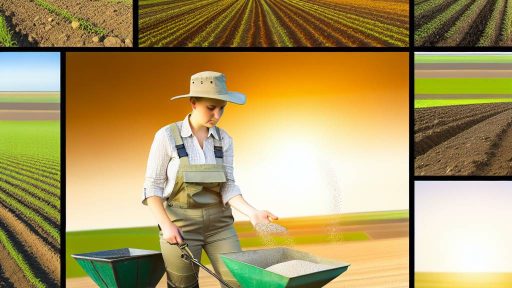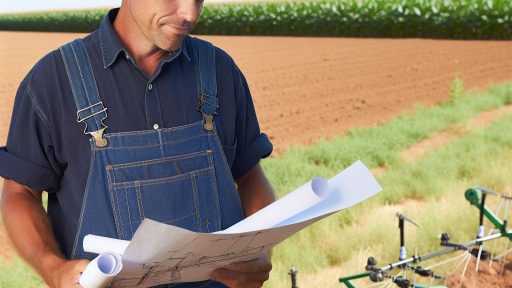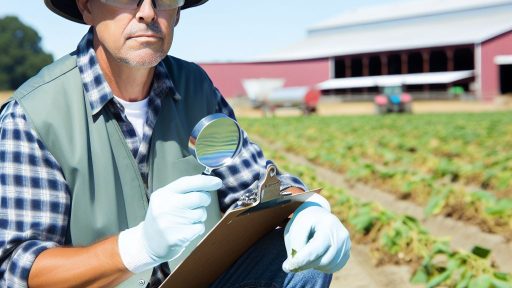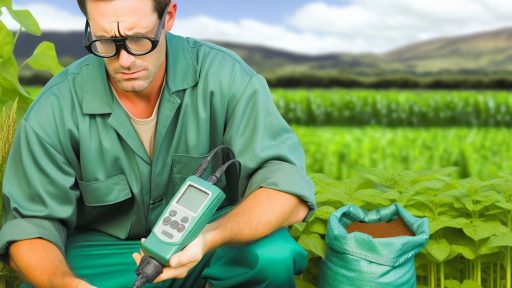Understanding the Importance of Strategic Harvesting in Crop Yield Maximization
The Role of Timing in Harvesting
Strategic harvesting requires careful attention to timing.
The right moment maximizes crop quality and yield.
Farmers must monitor maturity indicators closely.
Additionally, they should consider weather forecasts.
Suitable conditions contribute to optimal harvest outcomes.
Implementing Efficient Harvesting Techniques
Effective harvesting techniques increase productivity significantly.
Using advanced machinery can streamline the process.
Farmers should invest in equipment suited to their crops.
Regular maintenance of machinery enhances performance.
Training workers on new techniques also improves efficiency.
Understanding Market Demand and Crop Pricing
Market demand influences when to harvest crops.
Higher prices encourage early harvesting of certain varieties.
Farmers should stay informed about market trends.
This knowledge aids in making strategic decisions.
Collaborating with local distributors can enhance market access.
Transform Your Agribusiness
Unlock your farm's potential with expert advice tailored to your needs. Get actionable steps that drive real results.
Get StartedUtilizing Data and Technology
Technology plays a critical role in modern farming practices.
Data analytics can inform harvesting strategies effectively.
Farmers should leverage satellite imagery and sensors.
These tools provide insights into crop health and productivity.
Adopting precision agriculture can lead to significant yield increases.
Assessing Soil Health and Crop Rotation
Healthy soil is essential for maximizing crop yields.
Crop rotation helps maintain soil fertility.
Farmers should analyze soil health regularly.
Incorporating cover crops can enhance soil quality.
Soil assessments guide better harvesting choices.
Building Resilience Against Environmental Challenges
Environmental factors pose risks to crop yields.
Farmers can adopt resilient practices to counteract these challenges.
Implementing conservation techniques safeguards crops against droughts.
Additionally, they must prepare for pest infestations.
Understanding local climate trends can help in planning.
Identifying Optimal Harvesting Times for Different Crop Types
Understanding Crop Maturities
Different crops have varying growth cycles.
Understanding these cycles is crucial for maximizing yields.
Crops such as corn and soybeans mature at different rates.
Additionally, factors like climate and soil conditions impact growth time.
Monitoring Weather Patterns
Weather plays a significant role in harvesting decisions.
Optimal weather conditions enhance both quality and yield.
Farmers must monitor forecasts closely before harvests.
Sunny days can signal the right time for harvesting certain crops.
Utilizing Technology for Precision
Modern technology aids in determining optimal harvest times.
Showcase Your Farming Business
Publish your professional farming services profile on our blog for a one-time fee of $200 and reach a dedicated audience of farmers and agribusiness owners.
Publish Your ProfileRemote sensing and data analytics provide real-time information.
Drones can help assess crop health from above.
Soil moisture sensors assist in deciding when to harvest.
Coordinating with Local Experts
Collaboration with local agricultural experts proves beneficial.
Local universities and extension services offer valuable insights.
Understanding regional specifics can prevent costly mistakes.
Networking fosters a community of shared knowledge and resources.
Evaluating Market Conditions
Market demand influences harvesting strategies.
Harvesting too early or too late can affect prices.
Farmers should stay informed on market trends.
This knowledge helps in planning the best time to sell.
Utilizing Advanced Agricultural Technologies to Enhance Harvest Efficiency
Implementing Precision Agriculture
Precision agriculture utilizes technology for maximum efficiency in farming.
It includes GPS and sensors to collect real-time data on fields.
Farmers can track soil health and crop needs more effectively.
This approach helps in reducing waste and increasing yields.
Additionally, it allows for targeted interventions and precise resource application.
Adopting Smart Irrigation Systems
Smart irrigation systems optimize water usage during harvest seasons.
These systems use moisture sensors to determine irrigation needs.
By preventing overwatering, farmers save water and improve yields.
Moreover, they ensure that crops receive the right amount of hydration.
This efficiency leads to healthier plants and higher productivity.
Utilizing Drones for Crop Monitoring
Drones offer an innovative solution for crop monitoring and management.
They provide aerial views that highlight crop health and growth patterns.
This information assists farmers in making data-driven decisions.
Furthermore, drones can identify areas requiring attention and resources.
Ultimately, this leads to smarter and quicker operational strategies.
Integrating Automation into Harvesting
Automation plays a key role in improving harvest efficiency.
Automated harvesters can work faster than traditional methods.
They significantly reduce labor costs and increase harvesting speed.
Enhanced harvesting technology also minimizes crop damage.
Thus, farmers can maximize their overall yield during crucial seasons.
Leveraging Data Analytics for Decision Making
Data analytics aids in predicting crop yields and planning strategies.
Farmers can analyze historical data to determine optimal planting times.
This informs them about market trends and demand forecasts.
Consequently, timely decisions can lead to better financial outcomes.
Data-driven insights allow farmers to adapt to changes effectively.
You Might Also Like: Conservation Tillage Systems for Improving Water Retention
Implementing Sustainable Practices to Maintain Soil Health and Productivity
Importance of Soil Health
Soil health is crucial for sustainable agriculture.
It influences crop productivity and environmental quality.
Healthy soil supports plant growth and resilience.
Showcase Your Farming Business
Publish your professional farming services profile on our blog for a one-time fee of $200 and reach a dedicated audience of farmers and agribusiness owners.
Publish Your ProfileAdditionally, good soil structure enhances water retention.
Adopting Crop Rotation
Crop rotation prevents nutrient depletion in the soil.
It reduces the risk of pest and disease buildup.
Furthermore, different crops contribute varied nutrients.
This practice ultimately promotes soil biodiversity.
Using Organic Amendments
Organic amendments improve soil fertility and structure.
Compost and manure enrich the soil with nutrients.
These materials enhance microbial activity as well.
Consequently, they can boost crop yields significantly.
Minimizing Soil Disturbance
Conservation tillage can effectively minimize soil disturbance.
This practice preserves soil structure and biodiversity.
It also helps maintain moisture levels in the soil.
As a result, crops can thrive even in dry conditions.
Integrating Cover Crops
Cover crops play a vital role in soil health management.
They help prevent erosion and nutrient leaching.
Such crops can also fix nitrogen in the soil.
Consequently, they improve soil fertility and structure.
Fostering Biodiversity
Encouraging biodiversity can enhance ecosystem resilience.
Diverse plant species support a range of soil organisms.
This diversity helps combat pests and diseases effectively.
Moreover, it enhances overall soil health and stability.
Monitoring Soil Quality
Regular soil testing is essential for effective management.
This assessment provides insight into nutrient levels.
It helps in identifying deficiencies or imbalances.
Consequently, informed decisions can be made to amend soil issues.
You Might Also Like: Greenhouse Cultivation for Growing High-Value Vegetables and Herbs
Analyzing the Role of Weather and Climate Patterns in Harvesting Decisions
Understanding the Impact of Weather
The weather significantly influences crop growth and harvesting schedules.
For instance, excessive rain can delay field activities.
On the other hand, drought conditions can stress crops and reduce yields.
Farmers must stay informed about weather forecasts to make timely decisions.
Additionally, local weather patterns often determine the best planting and harvesting times.
Recognizing Climate Patterns
Climate patterns shape agricultural practices over the long term.
For example, changing rainfall patterns affect soil moisture levels.
Farmers might need to adapt their cropping systems accordingly.
Moreover, temperature trends can influence pest and disease outbreaks.
Understanding climate variations helps farmers plan for potential challenges.
Utilizing Technology for Weather Analysis
Advancements in technology improve weather analysis for farmers.
Tools like satellite imagery offer real-time weather updates.
Farmers can access data to optimize their harvesting strategies.
Additionally, predictive analytics help in long-term decision-making.
Showcase Your Farming Business
Publish your professional farming services profile on our blog for a one-time fee of $200 and reach a dedicated audience of farmers and agribusiness owners.
Publish Your ProfileEmbracing technology leads to enhanced crop yield and sustainability.
Implementing Strategic Harvesting Practices
Strategic harvesting requires a combination of knowledge and tools.
Farmers can utilize weather data to choose the optimal time for harvesting.
This practice maximizes yields and minimizes losses.
Moreover, adjusting techniques based on weather conditions can enhance efficiency.
Overall, weather analysis is crucial for successful agricultural ventures.
You Might Also Like: Essential Crop Disease Strategies For Profitable US Farmland Investments

Evaluating the Economic Impact of Harvesting Strategies on Rural Real Estate Ventures
Importance of Harvesting Strategies
Harvesting strategies directly influence crop yields in rural real estate ventures.
They affect profitability and sustainability for farmers and investors alike.
Implementing optimal techniques can maximize financial returns.
Understanding Different Harvesting Techniques
Advanced harvesting techniques vary significantly in efficiency.
For example, no-till harvesting preserves soil integrity while enhancing yields.
Conversely, traditional methods may lead to soil degradation.
Economic Benefits of Efficient Harvesting
Efficient harvesting reduces operational costs and maximizes output.
Lower costs can lead to increased profit margins for landowners and farmers.
Additionally, improved harvesting practices help secure higher market prices.
Factors Influencing Harvest Timing
Harvest timing is critical for crop quality and yield.
Weather patterns, crop maturity, and market demand all play significant roles.
Adapting harvesting schedules to these factors can enhance economic returns.
Evaluating Technological Advancements
Technological innovations greatly impact harvesting strategies.
Automated machinery improves efficiency and reduces labor costs.
Data analytics helps in making informed decisions throughout the harvest process.
Measuring Financial Success
Financial success stems from strategic planning and execution.
Monitoring market trends aids farmers in making timely decisions.
Regular assessments of harvest results guide future strategies.
Investment Opportunities in Harvesting Innovation
Investing in harvesting innovation can yield significant returns.
Advanced technologies present opportunities for higher efficiency.
Investors may focus on companies developing sustainable harvesting solutions.
Discover More: Greenhouse Construction for Agricultural Land Buyers
Integrating Crop Rotation and Diversity to Boost Overall Yields
Importance of Crop Rotation
Crop rotation is essential for maintaining soil health.
Different crops have varied nutrient requirements.
This method prevents soil depletion over time.
Additionally, it disrupts pest cycles naturally.
Farmers can achieve higher yields through strategic planning.
Moreover, rotating crops enhances microbial diversity in the soil.
Benefits of Crop Diversity
Diverse crops can attract beneficial insects.
These insects play a crucial role in pest control.
Furthermore, crop variety can improve resilience against diseases.
This approach leads to a more sustainable farming system.
Farmers can tailor their selections to specific environmental conditions.
Showcase Your Farming Business
Publish your professional farming services profile on our blog for a one-time fee of $200 and reach a dedicated audience of farmers and agribusiness owners.
Publish Your ProfileImplementing a Crop Rotation Plan
Creating a rotation plan involves several key steps.
- Assess soil health and nutrient levels.
- Choose crops based on compatibility and requirements.
- Establish a timeline for planting and harvesting.
Regularly evaluating the plan ensures its effectiveness.
Adjustments may be necessary based on yield outcomes.
Real-World Examples
Many successful farms utilize crop rotation and diversity.
For instance, Green Acres Farm rotates corn and soybeans.
This practice has significantly increased their annual yield.
Likewise, Riverbend Farms integrates legumes into their rotation.
This strategy enriches soil nitrogen levels and boosts productivity.
Additional Strategies for Maximizing Yields
Alongside crop rotation, consider cover cropping.
Cover crops prevent erosion and improve soil structure.
Integrating technology can also enhance monitoring and management.
Implementing precision agriculture provides data-driven insights.
These complementary strategies collectively boost overall yields.
Training and Educating Farmers on Best Harvesting Practices and Techniques
Importance of Education
Education plays a critical role in modern agriculture.
Farmers need to stay informed about best practices.
Knowledge enhances their ability to improve crop yields.
Furthermore, it helps them adapt to changing conditions.
Workshops and Training Sessions
Organizing workshops is an effective way to share knowledge.
These sessions can focus on new harvesting technologies.
Additionally, they can cover traditional techniques that are still effective.
Farmers can learn from experts in their fields.
For instance, local agricultural colleges might offer support.
Field Demonstrations
Field demonstrations allow farmers to see techniques in action.
These hands-on experiences enhance learning significantly.
Farmers can practice using advanced harvesting equipment.
Moreover, they can observe the benefits firsthand.
Collaboration with Agricultural Organizations
Collaboration with agricultural organizations can be beneficial.
Organizations can provide resources and expert knowledge.
They may also offer financial assistance for training initiatives.
In this way, farmers can improve their harvesting strategies together.
Utilizing Technology and Online Resources
The internet offers a wealth of information on harvesting practices.
Farmers can access online courses and webinars from experts.
This flexibility allows them to learn at their own pace.
In addition, social media can connect them to a community of peers.
Continuous Improvement and Feedback
Farmers should embrace continuous improvement in their harvesting techniques.
Regular feedback can guide their practices moving forward.
Surveys and discussions can help gather insights from the farming community.
This engagement ensures that they remain informed and effective.
Additional Resources
Exploring the Potential for Water-Limited Agriculture in the San …
Soil Health Principles and Practices | Farmers.gov
Showcase Your Farming Business
Publish your professional farming services profile on our blog for a one-time fee of $200 and reach a dedicated audience of farmers and agribusiness owners.
Publish Your Profile



